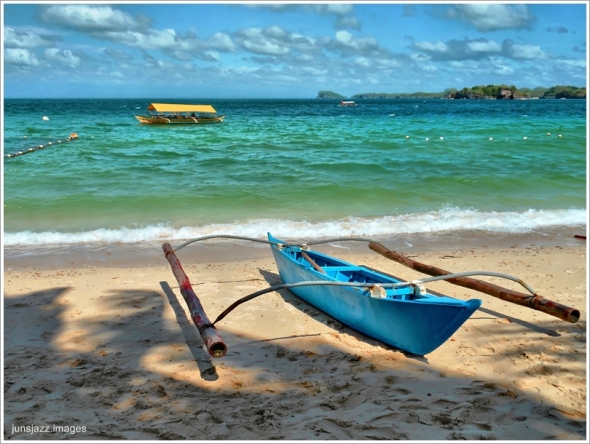Put some textures
Observe the picture above. There are layers of textures there – the powdery sand that has seen its share of hundreds of footsteps (or sandal marks), the white strip of surf crashing on shore, the tips of aqua green waves readying their final trip towards land, those fluffy pieces of clouds on their heavenly sojourn, the rocky outcrop of mountains and islands on the horizon. Does this add clutter and confusion to the picture? No, because texture is not the first thing you’ll notice but the blue banca (outrigger canoe) that sits quietly in contrast to its surrounding. The textures here provide an interesting menagerie of patterns, colors, shadows and highlights. Though texture can be a central subject, they can be effective secondary pieces in support of the point of interest. Look out for texture. Designers and graphic artists use them for backgrounds and to fill spaces. But photographers can use texture as a more powerful element – much like shape, patterns, color and light – for subject or composition.
Shoot in color then convert to B&W
Article Excerpt: “A word of advice, never shoot using the in camera black and white setting. Even though some cameras give you some control with different black and white types, it is better to take the photos in color and then convert them in an editing program. That way, you will have more control over the final result and you will always have a color version of the photo in case you changed your mind and decided the color version is better. So, shoot in color and convert to black and white later, and remember to get an exposure as accurate as possible in order to pass smoothly through the conversion stage…Whatever the thing you want to photograph, the first stage is always preparation and shooting. The human eye sees only in color which is, of course, absent in black and white photos. In this monochromatic reproduction of the world, it’s necessary to find other elements that would highlight the subject. You are only left with lighting, textures, lines and shapes to make the photo stand out.”~Yassine Hakimi from his article The Magic of Black and White Photography
Photo Quotes 69
What do we see when we go to Nature? We see exactly what we are trained to see, and, if we are lucky, perhaps a little more but not much…~Henry Peach Robinson (Photo location: Oton, Iloilo province)
Still life is “full control” photography
A picture is not a painting, but if I can make it look like one, why not? Still life is one of the earliest photography genres borrowing the style of master painters of the past. Still life photography does not need expensive, elaborate studio set-up. Natural light or a couple of lamps will do, and you can set it up right at home. As such you can have full control over the variables – composition, lighting, exposure, angles – and you can have all day to do your shot. Something which you can’t do with a model (unless you’re the agency) or a mountain (try going to the other side of a mountain to get another angle). The options and possibilities of still life photography will squeeze out your creative juices. British freelance photographer Simon Bray shares some fundamentals in his article 10 tips to Getting Started with Still Life Photography. This photo genre is in demand nowadays and you’ll find these kinds of images in photo stock sites. Designers, advertisers, visual artists and websites have uses for still life imagery. The bottomline? Bray points out the only requirement is a camera, strong backgrounds and good light. I will add a couple of things: follow your photographer’s instinct and turn on that “inner” eye. Happy still life shooting! (Photo location: at a cafe in Roxas City, Capiz province)






















